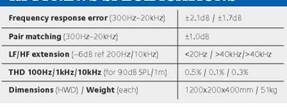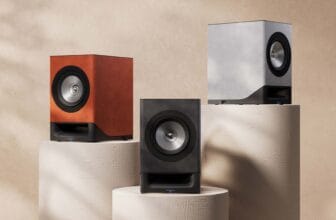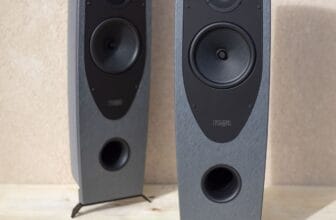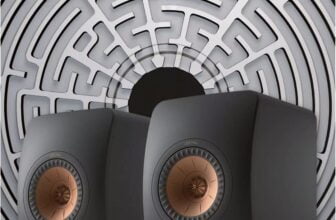Kii Audio THREE BXT review
If there was anything wrong with the Kii Audio Three, it’s fixable at a stroke by adding the BXT extension module. Read our Kii Audio THREE BXT review.
Review: Keith Howard & Andrew Everard
Lab: K. Howard
Six-driver, DSP-controlled active speaker/eight-driver sub
Made by: Kii Audio, Bergisch Gladbach Germany
Supplied by: Sound Design Distribution Ltd, Cardiff, UK
Telephone: (0)800 009 6213
Web: www.kiiaudio.com; www.sounddesigndistribution.co.uk
As the moving-coil loudspeaker approaches its centenary you could say plus ca change – much about it has changed, but some things remain stubbornly the same. For instance, for a large slice of the loudspeaker’s lifetime, designers and enthusiasts have argued over how sound should be radiated into the room. Should a speaker ‘beam’ its sound towards the listener, thereby quelling the room’s contribution as much as possible? Or should it fire sound in all directions, engaging the room as much as possible?
Whatever your philosophical stance on this, the plain fact is that most loudspeakers, old and new, do a bit of both: they are omnidirectional at low frequencies, where the wavelength of sound in air is long, and directional at high frequencies, where the wavelength is short.
There’s probably a broad consensus among speaker designers that constant directivity is desirable, but it’s a difficult ideal to achieve. Notionally it can be had passively using the ‘acoustic resistance box’ to create a radiation pattern like the polar pattern of a cardioid microphone – but it’s hard to realise in practice and, as far as I’m aware, only Finnish company Gradient Labs has ever offered speakers which attempt this over a wide frequency range.
DIRECTIVITY BY DSP
Recently we’ve seen another approach gain traction – multi-driver active speakers with clever DSP controlling the directivity. B&O began the trend with its large, costly BeoLab 90 [HFN Dec ’16]. Then start-up Kii Audio arrived with the Kii THREE [HFN Aug ’18], a simpler, smaller, less ambitious design at a much lower price point.
Recipient of wide critical acclaim, the Kii THREE had just one obvious shortcoming – it was too compact to deliver prodigious bass capability. Hence what you see here, the Kii THREE BXT – the Kii THREE
atop a ‘bass bin’, although that demeaning terminology does no justice to what is the logical culmination of the Kii design approach. Existing THREE owners can buy a pair of BXTs, and custom finishes are more expensive.
In each THREE BXT there are 10 Ncore Class D power amplifiers. The THREE itself, which can be removed from the BXT and used independently if required, contains six – one per drive unit (tweeter, midrange, two side-firing drivers, and two rear-firing drivers). Using designer Bruno Putzeys’ own adjective, the BXT is less ‘profligate’ in that it has ‘just’ four amplifiers driving its eight drivers (four forward-firing, four side-firing) in pairs, each amplifier being rated at a maximum output of 500W/2ohm.
WORKING IN UNISON
There is no crossover as such between the THREE and BXT. Rather, the BXT supplements the THREE below 250Hz, mimicking its behaviour while dividing the LF output among a larger number of drive units. As with the THREE, the THREE BXT radiates omnidirectionally up to 50Hz before transitioning to cardioid radiation above 80Hz. This is maintained up to 1kHz, at which point the directivity becomes dominated by that of the tweeter. It’s this surrendering of DSP directivity control at HF which makes the THREE so much less complex than the BeoLab 90.
The benefit of cardioid directivity is simple – it radiates 4.8dB less energy into the room for the same on-axis SPL than an omnidirectional radiation pattern, which means you hear more of the loudspeaker and less of the room. Arguably as important as the constrained radiation
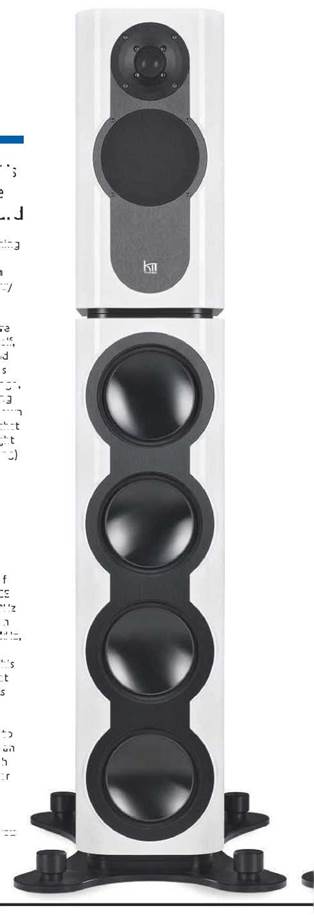
RIGHT: Sliding a THREE onto the BXT adds four amplifiers and eight drive units, considerably increasing bass output capability while retaining cardioid directivity from 80Hz to 1kHz. Bass extension also increases slightly
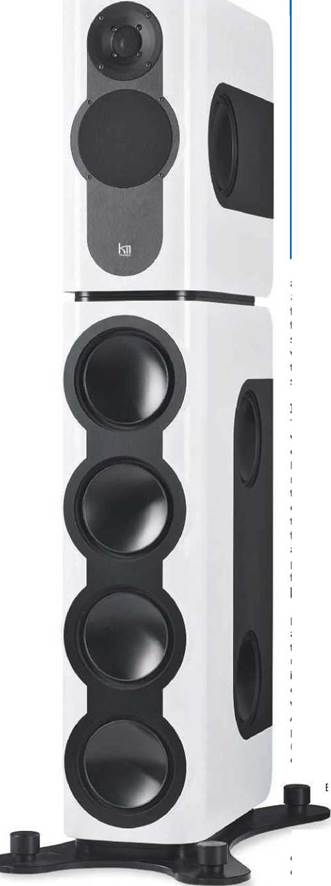
KII-PING IN CONTROL
Although the THREE BXT can be used ‘as is’, most buyers will want to add the optional Kii Control external controller/preamp. With it, digital input options are considerably expanded to include coaxial and optical S/PDIF (maximum sampling rates 192kHz) as well as USB, which supports PCM files up to 384kHz and DSD files up to DSD128. In addition, the controller provides volume, source selection and mute controls alongside armchair adjustment of the DSP’s boundary and contour filtering, facilitated by a small OLED display. Although the Kii Control uses a wired connection to the master THREE BXT, the main functions can also be remote controlled using either an Apple Remote or RC-5 protocol IR handset. Some potential buyers will inevitably question why Wi-Fi isn’t supported to allow control via iOS/Android apps, but perhaps that will come. Others will thank heaven for a proper, chunky control solution with real buttons and a real volume knob that won’t get lost down the back of the sofa and never tells you it’s having a problem connecting with the network! KH
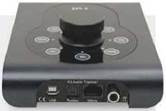
angle is that it’s essentially constant from 80Hz to 1kHz, which means that – over this frequency range at least – early reflections from room boundaries will have the same spectral content as the direct sound, which makes it easier for us to recognise them as reflections and fuse them with the speaker’s forward output.
drivers it kicks in at 10dB higher SPL than with the THREE alone. A graph on the Kii Audio website shows the THREE BXT’s peak output capability to be 115dB SPL (distance not specified, probably 1m) down to 60Hz, below which it decreases at 12dB per octave. This is with the BXT’s boundary gain control set to ‘F’ (flat); if the LF response is adjusted for ‘W’ (near-wall) or ‘C’ (near-corner) use then the 115dB SPL limit is retained down to even lower frequencies, depending on the exact setting chosen.
FLEXIBLE POSITIONING
Temptation to lower the frequency at which the omni to cardioid transition occurs with the BXT was resisted, says Putzeys, because this ‘eats into headroom rather quickly’. But the opportunity was taken to lower the bass roll-off from 30Hz down to 20Hz (-3dB). And the BXT, like the THREE, incorporates compensation for room boundary gain, a screwdriver- adjusted rotary control on its upper rear panel allowing adjustment for use near a wall or corner [see Lab Report, p39].
DSP driver excursion protection is implemented as previously, by sliding the bass corner frequency upwards, but with the increased number of
Mating the THREE and BXT is easy, as is decoupling them. The THREE slides into position on lipped rails, and short electrical connections for mains power, signal and data are made between the rear panel of the THREE and top rear panel of the BXT. External power, data and signal connections are then made to the BXT’s lower panel, with a three-pin XLR providing for either analogue or AES/EBU digital inputs. USB, Toslink optical and coaxial S/PDIF inputs are available via the optional Kii Control wired remote [see boxout, above], which also provides volume and access to DSP functions like tone control.
INSTANT INTEGRATION
Considering the complexity of this speaker system – not least those 14 drive units per channel, plus all the DSP and amplification – it’s laudable that the first impression the Kii THREE/ BXT creates when fed from editor PM’s reference Melco server/player via the Kii Controller is one of total integration [writes Andrew Everard]. There’s no sense of parts of the frequency range being shuffled between drivers, as can sometimes be the case with less well thought out multi-driver speakers.
Instead, this set-up simply sounds like a pair of very high-quality monitors (which the THREEs are) with very decent bass extension (from the BXTs) – not that the Kii THREEs used ‘solo’ are exactly lacking in respectable low-end ability. After all, these compact monitors already have four actively-driven16.5cm bass drivers apiece.
So, with all that ability already in the ‘head unit’, it would have been easy to overcook things by adding another
‘The term “bass bin” does no justice to Kii’s design’
eight(!) bass units to each speaker, but it’s to the credit of Kii Audio’s designers, and
their DSP, that there’s nothing overblown or artificial going on here.
Rather, the THREE/BXT package hangs together as if it was designed as a single speaker, a supposition clear right from the sparkling opening notes of Britten’s Piano Concerto, played by Howard Shelley and the BBC Philharmonic under Edward Gardner [Chandos CHAN10764; 96kHz/ 24-bit]. The percussive attack shows the speed and definition of the speakers, and their ability with the microdynamics of the music, and the balance between the solo instrument and
the orchestra manages to sound entirely natural while retaining insight into both the score and performance.
ON YOUR MARKS…
This controlled, revealing nature is retained with the better-known Violin Concerto, the sweet tone of Tasmin Little’s instrument soaring above the repeating motifs of the orchestra, after a darker opening laden with thrilling percussion.
Off to a good start, then, but still Donald Fagen’s title track from Morph The Cat [Reprise 9362499752; 96kHz/24-bit] takes the listener by surprise, the Kii combo slamming into the track with a literal kick in the drums before the whole kit springs into life, soon joined by a satisfyingly grumbly and tight bass and the chiming keyboards, guitar and then brass. Fagen’s
‘Above all, they just sweep you along with the music’
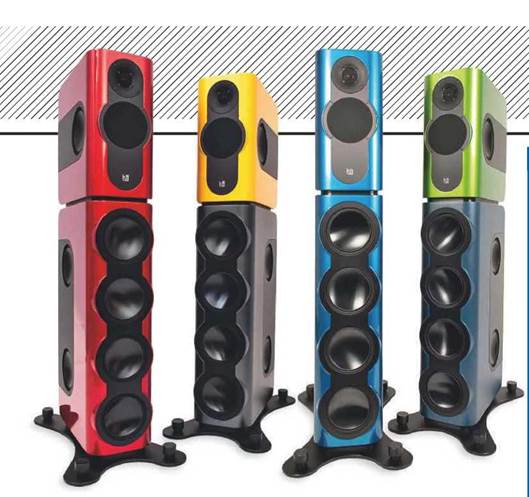
ABOVE: Standard finishes are high gloss white or graphite satin metallic. Custom high gloss,
matt or metallic finishes can be ordered for a £ premium. You can even specify different colours for the THREE and BXT, as illustrated!
voice has bags of character, with no sign of the sibilance some speakers can elicit, and as the track gets busier and the mix denser, the speakers just let it do so, with no confusion or compression.
Simple though its instrumentation may be, Iiro Rantala’s take on ‘Caravan’, from his My History Of Jazz set [ACT 9531-2] still challenges systems with its speed and detail. It’s driven by
rhythms in the piano’s left hand, and then violin on top, and these speakers give each instrument its space without making a song and dance about how clever they’re being.
In other words all the quality here is subservient to the main task of making music rather than technical showboating, and the same goes for soundstaging – broad, deep and focused, it’s just there, a stage on which the performances are set.
It’s this combination of extreme ability combined with an almost insouciant ease that sets these Kii speakers apart. Even with the least complex music – in this case Keith Jarrett’s The Koln Concert [ECM 1064/65; DSD64] – the quality of the Kii Audio speaker system is evident in the luminous piano sound and ambience, with the way each note decays into the space, Jarrett’s exertions and the thud of the
BRUNO PUTZEYS
Kii Audio’s ‘full stack’ – the THREE ‘satellite’ and BXT bass module – is hardly fresh off the boat. Indeed, the combo was debuted in the UK as far back as our Hi-Fi Show Live 2018, developing into one of the stand-out sounds at the Hi-Fi Show Live 2019 in Ascot. Rather than guess what the brand will unveil at this year’s Hi-Fi Show Live (19th-20th Sept, Ascot), I asked CTO Bruno Putzeys to offer a hint of what’s to come.
‘Kii Audio has arrived at that point in a company’s life when its future actions become more predictable,’ said Bruno, ‘as are the questions asked about its future.’ Questions that spring to my mind at least include: 1. will Kii make an even smaller speaker? 2. will Kii make a bigger speaker with all the latest technology embedded within? And, 3. will Kii launch a digital networked source?’
‘Like most companies we don’t
like to pre-announce,’ demurred Bruno, ‘but unlike others that’s not because we fear people will hold off a purchase in favour of a marginally better new model. We don’t do marginal, and we don’t do a mkII. We’re not in the business of making finely-graded speaker lineups with a multiplicity of tiers and sizes that leave prospective customers baffled as to which to choose.
‘You can be sure that any new products will be sufficiently distinctive from the existing ones, and from each other, to leave no doubt which is the right one for you.’ I’ll take that as a ‘yes’ to all three of those questions! PM

pedals laid out for inspection, as is the beauty of the tumbling musical expression. It’s a recording so familiar as to be almost a hi-fi cliche, but via these speakers it’s again captivating, almost mesmerising.
BASS WITHOUT BOOM
You definitely get that ‘bass you feel as well as hear’ effect, but it’s so well-controlled and tautly-defined that it can sound less than ‘obvious’. Those BXT cabinets aren’t really subwoofers after all, low though they go: instead they just extend the remarkable abilities of the THREE speakers to give an altogether more full-bodied sound, and all without drawing attention to themselves.
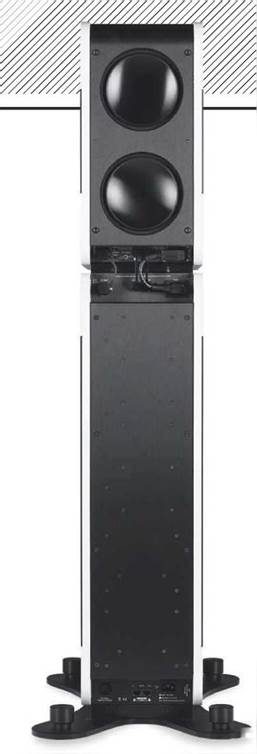
LEFT: Unlike the THREE, the BXT has no rear drivers, just forward-firing and side-firing ones. Two panels on the BXT provide for connection to the THREE (top) and external inputs (bottom)
Pink Floyd’s ‘High Hopes’ [The Division Bell; Legacy/Columbia, 96kHz/24-bit], just about shows everything the THREE/BXT combo can do, from the open and spacious ambience of the intro, with its sounds of nature and distant church bells already grabbing the listener’s attention before the vocals and bass grumble. Again there’s that sense of clarity, of listen-in detail even when the mix is dense but, above all, they just sweep you along with the music.
With the Swedish Radio SO/ Ticciati recording of Berlioz’s Romeo & Juliette [Linn CKD 521; 192kHz/24-bit], the ability of the THREE/BXT to convey a full-blooded orchestral event while maintaining finesse is much in evidence. The bass is rich, conveying the scale of the musical forces, but that tight control powers the piece along, with the instrumental textures – the richly metallic brass – crisply defined.
That deft low-down punch, delivered as part of the musical whole, is highly addictive. Playing the Neil Cowley Trio’s ‘Rooster Was A Witness’ [The Face Of Mount Molehill, Naim NAIMCD 171], the sheer rhythmic drive of the relentless, metronomic drums and bass of Evan Jenkins and Rex Horan, forming the foundation for Cowley’s percussive, charging piano, is every bit as exciting as I recall from seeing the group live. And that, simply, is what the Kii THREE/BXT does.
VERDICT
LAB REPORT
KII AUDIO THREE BXT
Although it’s only one of the benefits of using DSP in an active loudspeaker, well controlled frequency response is something you expect and the Three BXT delivers. While it’s possible using DSP to achieve a ruler-flat frequency response at a particular point in space, Kii Audio has a more realistic approach to equalisation, which is not individually customised for each speaker and seeks only to correct larger anomalies which are present in both the on- and off-axis responses. So at 1m on the axis of the midrange driver the forward frequency responses [Graph 1, below] proved to be largely flat in trend but without minor wiggles being ironed-out. The resulting response errors, 300Hz to 20kHz, are modest at ±2.1dB and ±1.7dB respectively, and reduce further to ±1.3dB and ±1.4dB over the range 400Hz to 10kHz. This is probably flat enough for any departure from absolute tonal neutrality to pass unnoticed.
Pair matching error over the same 300Hz-20kHz is an acceptable ±1.0dB and reduces to an outstanding ±0.5dB if the upper frequency limit is reduced by a little over an octave to 9.2kHz. These figures don’t quite match those we recorded from the Kii Audio THREE [HFN Aug ’18], but they remain impressive. Performing a nearfield bass response measurement with the THREE BXT is complicated by the large number of drive units involved, but that measurement issue aside it’s clear that the THREE BXT has a bass output that’s effectively flat to below the audible frequency range.
When the rear panel rotary control was moved from F (flat) to W (adjusting bass output for positioning near a wall), output was measurably reduced by about 8dB at 20Hz (re. 100Hz), and further reduced to about 17dB when the control was rotated right around to C (corner location). As there are six intermediate settings between the ‘F’ and ‘W’ positions and between the ‘W’ and ‘C’ positions, it should be possible to adjust the THREE BXT’s bass output to suit most installations. The CSD waterfall [Graph 2] reveals some low-level treble resonances. KH
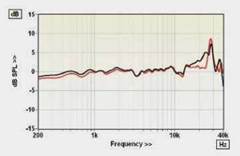
ABOVE: The Kii Audio THREE BXT’s forward response is remarkably flat and even, with a sub-20Hz bass
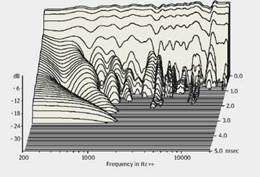
ABOVE: Cabinet is well damped with only low-level driver resonances visible between 3kHz-10kHz
SPECIFICATIONS
